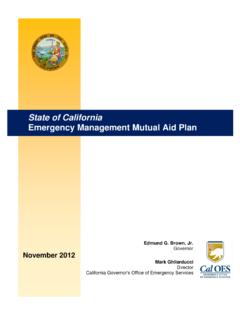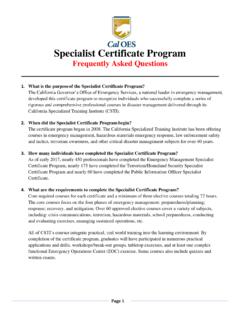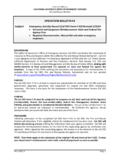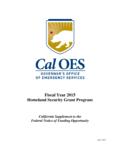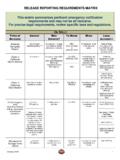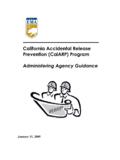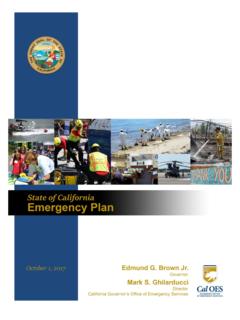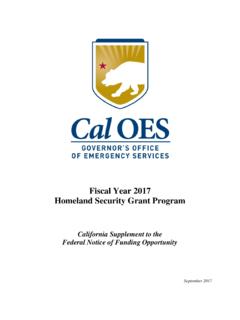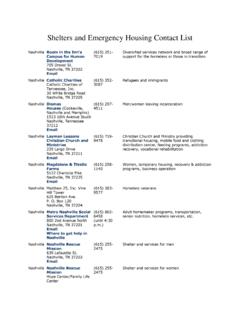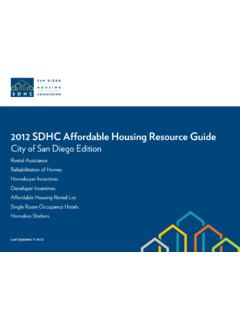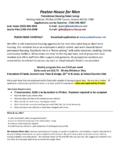Transcription of FINAL DRAFT 10/30/2013 Emergency Function 6 …
1 FINAL DRAFT 10/30/2013 . Emergency Function 6. care and Shelter Annex EXECUTIVE SUMMARY. OCTOBER 2013 . California Health and Human Services Agency California Department of Social Services POC: Emergency Function 6 care AND SHELTER. EXECUTIVE SUMMARY. Emergency Function 6 care AND SHELTER. Introduction The mission of Emergency Function (EF) 6 care and Shelter is to protect life and reduce suffering from natural and human-caused emergencies. The EF 6 Annex to the State of California Emergency Plan (SEP) defines the scope of EF 6 and the Emergency management activities it can support. Although the annex provides a concept of operations for overall coordination of activities that would take place under EF 6, it is not an operational plan.
2 A. companion document to this annex, the California Department of Social Services (CDSS). Department Operations Center (DOC) Operations Guide, presents more operational details for how EF 6 would Function before, during, and after an Emergency activation. Purpose and Scope EF 6 includes four main functions , each of which has sub- functions . They are summarized below and elaborated on in the annex. - care and shelter - Emergency assistance - Human services - Support for transition to interim housing As part of its response support role, EF 6, in coordination with other EFs as appropriate, will support the Emergency management community in addressing individuals in need of additional assistance. These individuals may include people with disabilities and others with access and functional needs ( , populations whose members may have additional needs before, during, and after an Emergency in functional areas, including but not limited to maintaining independence, communication, transportation, supervision, and/or medical care ).
3 EF 6 supports all individuals, including, but not limited to: - Residents from institutional settings - Elderly - Children - Members of culturally diverse societies - Individuals with limited English proficiency or who are non-English speaking - People with limited access to transportation Although not always explicitly stated in the annex, providing services to people with disabilities and others with access and functional needs is implicit throughout it. There are specific places where access and functional needs are discussed separately, but these discussions do not imply that these topics are the only ones where these services are covered. Governor's Office of Emergency Services | EF 6 Executive Summary | October 2013 Page 2.
4 Emergency Function 6 care AND SHELTER. EXECUTIVE SUMMARY. Lead, Primary, and Supporting Agencies/Departments The Lead, Primary, and Supporting Agencies/Departments are the stakeholders for EF 6. Collaborative efforts among resource stakeholders, including local, state and tribal governments, federal partners, public/private partnerships, nongovernmental organizations/community-based organizations, and private sector groups will result in identifying valuable assistance and resources. Based on its authorities and responsibilities, the California Health and Human Services Agency (CHHS) is the designated Lead Agency/Department for the development of EF 6. The CDSS is the designated lead department for EF 6, and as such is responsible for facilitating the development, implementation, and maintenance of the EF 6 Annex with input and assistance from the stakeholders.
5 CHHS will work with CDSS to designate an EF 6 Coordinator. The EF 6 Coordinator works out of the CDSS DOC to facilitate collaboration among stakeholders, enhance information-sharing processes, and assist in coordinating resource allocation by providing information about the capabilities and resources of EF 6 stakeholders. The EF 6 Coordinator will work closely with the Regional Emergency Operations Centers (REOC) or State Operations Center (SOC) to facilitate the timely identification of resources and filling of resource requests in support of mass care and shelter operations. The EF 6 Coordinator does not have authority to commit resources or staffing or to represent the policy positions of EF. 6 stakeholders.
6 That authority remains with the representatives from stakeholder agencies and departments. Other state agencies and departments assist in the development of the EF 6 plans and programs. These Supporting Agencies/Departments have existing responsibilities in assisting the coordination of all phases of Emergency management. A full list of supporting stakeholders can be found in the complete annex. Exhibit 1: Emergency Function Stakeholder Roles California State Agency/Department Roles Emergency Function Coordinator - Provides EF 6 staffing and contact information in order for SOC or REOC officials to have continuous access to the EF 6 during the incident period and until Emergency personnel are demobilized - Establishes and maintains communication and coordination between the EF 6 stakeholders and the activated REOC, SOC, or Joint Field Office (JFO).
7 - At an activated REOC, SOC, or JFO, reports to the Operations Section Chief. If a JFO is activated, the EF 6. Coordinator will also coordinate with the Individual Assistance Branch and federal Emergency Support Function (ESF) #6. - Reports on EF 6 resource capabilities to address resource requests and work with the ESF #6 Coordinator to Governor's Office of Emergency Services | EF 6 Executive Summary | October 2013 Page 3. Emergency Function 6 care AND SHELTER. EXECUTIVE SUMMARY. California State Agency/Department Roles identify potential federal resources that may supplement EF 6 operations - Provides EF 6 perspectives, issues, and intelligence that may be used in REOCs, SOC, or JFO briefings, Action Plans, Advance Plans, or other similar meetings or documents - Provides situational status to the REOCs, SOC, or JFO Operations Section Chief in coordination with the DOC, CHHS departments, and other EF 6 stakeholders.
8 Provides technical and situational guidance to REOC, SOC, or JFO staff, state agencies, and others involved in the Emergency response and recovery and assists with directing questions and issues to the appropriate entity California Department of Social Services (CDSS). - Serves as the Lead Agency/Department in coordinating resources needed to support care and Shelter response ( , EF 6). - Identifies state agency resources that may be available for support in care and shelter - Administers the Emergency Food Assistance Program that distributes Department of Agriculture commodities to eligible households and Congregate Feeding Agencies - Coordinates the Volunteer Emergency Services Team (VEST) program that provides trained state personnel to support sheltering and Local Assistance Center (LAC) operations - Administers the State Supplemental Grant Program (SSGP) that may provide financial assistance to people who have suffered damages and losses in a disaster area declared by the President, when the FEMA Individuals and Households Program (IHP)
9 Is implemented - Coordinates the Functional Assessment Service Team (FAST) program that provides trained government employees and community-based organization staff to conduct functional assessments of people with disabilities and others with access and functional needs to determine what resources are needed so that an individual can remain in the general population shelter - Runs the CalFresh Program (also known as the Disaster Supplemental Nutrition Assistance Program [D-SNAP]), to meet the temporary nutritional needs of victims following a natural disaster Primary Agencies/Departments Agency/Department Role California Health and - CHHS may assign primary and support roles to those departments with authorities, Human Services capabilities and resources necessary to meet Emergency needs Agency (CHHS) - Department of Health care Services - Provides information on bed availability at skilled nursing facilities in affected areas - Coordinates with local mental health providers and Cal OES, Individual Assistance, on the assessment and need for providing services through the FEMA Crisis Counseling Program (CCP)
10 Grant - Department of Developmental Services - Provides facilities for shelter, food preparation, and medical equipment/supplies for individuals residing in state-operated facilities, to the extent possible - Provides consultation and assistance in accessing shelter space for individuals with developmental disabilities - Department of Public Health - Ensures the safety of food, drugs, medical devices, and other consumer products in the disaster area - Regulates bottled drinking water plants and distributors and drinking water haulers to ensure the safety of bottled or hauled water used as Emergency supplies of drinking water - Provides support to local health departments for infectious disease surveillance, Governor's Office of Emergency Services | EF 6 Executive Summary | October 2013 Page 4.
